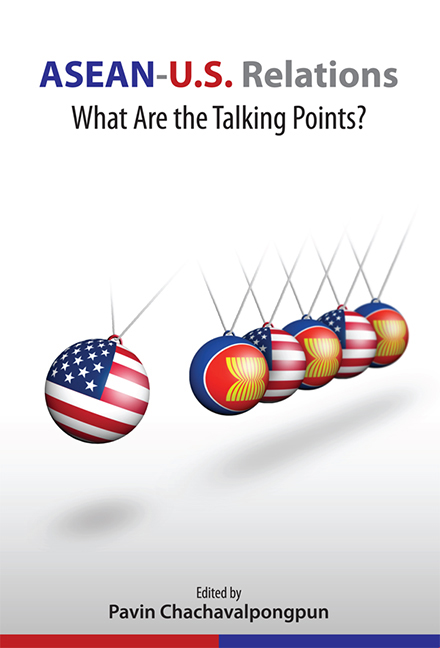Book contents
- Frontmatter
- Contents
- List of Tables and Figures
- Preface
- Contributors
- List of Abbreviations
- OVERVIEW
- 1 U.S. Engagement with ASEAN
- 2 ASEAN-U.S. Relations
- 3 Developments in ASEAN-U.S. Relations
- 4 The United States, Russia to be Part of East Asia Summit
- 5 How Does the United States Play into the East Asia Summit for ASEAN?
- QUINTESSENTIAL ISSUES
- Index
4 - The United States, Russia to be Part of East Asia Summit
from OVERVIEW
Published online by Cambridge University Press: 21 October 2015
- Frontmatter
- Contents
- List of Tables and Figures
- Preface
- Contributors
- List of Abbreviations
- OVERVIEW
- 1 U.S. Engagement with ASEAN
- 2 ASEAN-U.S. Relations
- 3 Developments in ASEAN-U.S. Relations
- 4 The United States, Russia to be Part of East Asia Summit
- 5 How Does the United States Play into the East Asia Summit for ASEAN?
- QUINTESSENTIAL ISSUES
- Index
Summary
Towards the end of October 2010, the heads of government of the Association of Southeast Asian Nations (ASEAN) gathered in Hanoi for the second time that year, as called for in the new ASEAN Charter. Afterwards, they met with their counterparts, collectively and individually, from China, Japan and South Korea in the context of ASEAN Plus Three, and then with the Prime Minister of India. They then sat down with the leaders of Australia, China, India, Japan, Korea, and New Zealand in the annual East Asia Summit (EAS). What was different from previous EAS was that the Russian Foreign Minister, Sergei Lavrov, and the U.S. Secretary of State, Hillary Rodham Clinton, were in attendance, representing their respective leaders “as special guests of the Chair”.
One of the most momentous decisions that the EAS leaders made was to “invite the Russian Federation and the United States of America, given their expressed interest in and commitment to the EAS process, to join the EAS in 2011”, having before them the recommendation of their foreign ministers.
In July 2009, the ASEAN foreign ministers had their annual meeting in Hanoi, Vietnam's capital. They then convened with ministers of the major powers and others from the Asia-Pacific in the ASEAN Regional Forum (ARF), the only region-wide ministeriallevel forum for the discussion of political and security issues. The ASEAN ministers also met with their counterparts in an ASEAN Plus Three setting and had informal consultations with those of the other members of the EAS.
Easily one of the most noteworthy subjects of these gatherings was the prospect of Russia's and the United States’ future participation in the region's rapidly evolving and increasingly complex political configuration, economic relationships, and transnational cooperation through their membership in the EAS. According to their chairman's statement, the EAS ministers’ “informal consultations … welcomed the expressed interest of the Russian Federation and the United States to join the East Asia Summit (EAS) and supported ASEAN's decision on the matter”. The ministers are said to have “noted” that the ASEAN ministers would recommend to the ASEAN leaders at their Hanoi summit in October that they “formally” invite Russia and the United States to join the EAS.
- Type
- Chapter
- Information
- ASEAN-U.S. RelationsWhat Are the Talking Points?, pp. 17 - 20Publisher: ISEAS–Yusof Ishak InstitutePrint publication year: 2011



